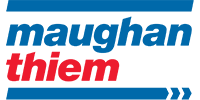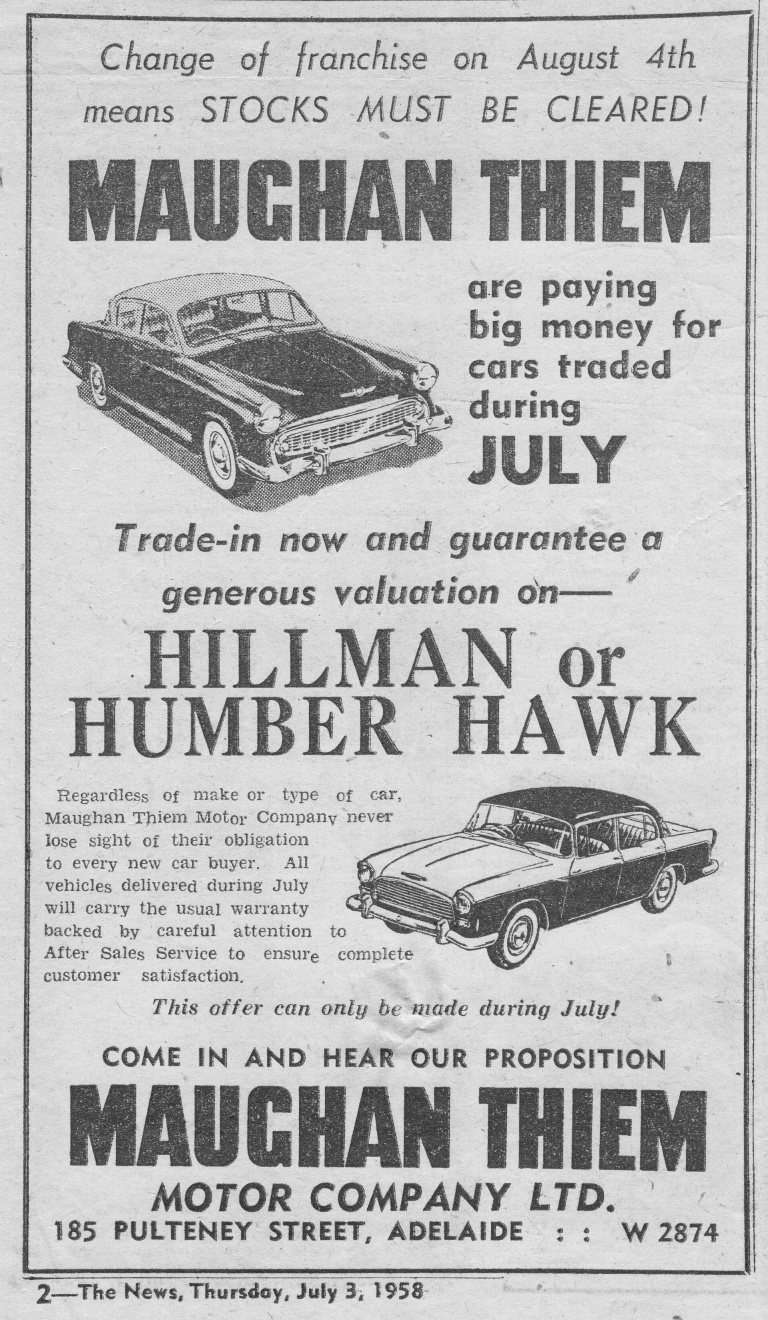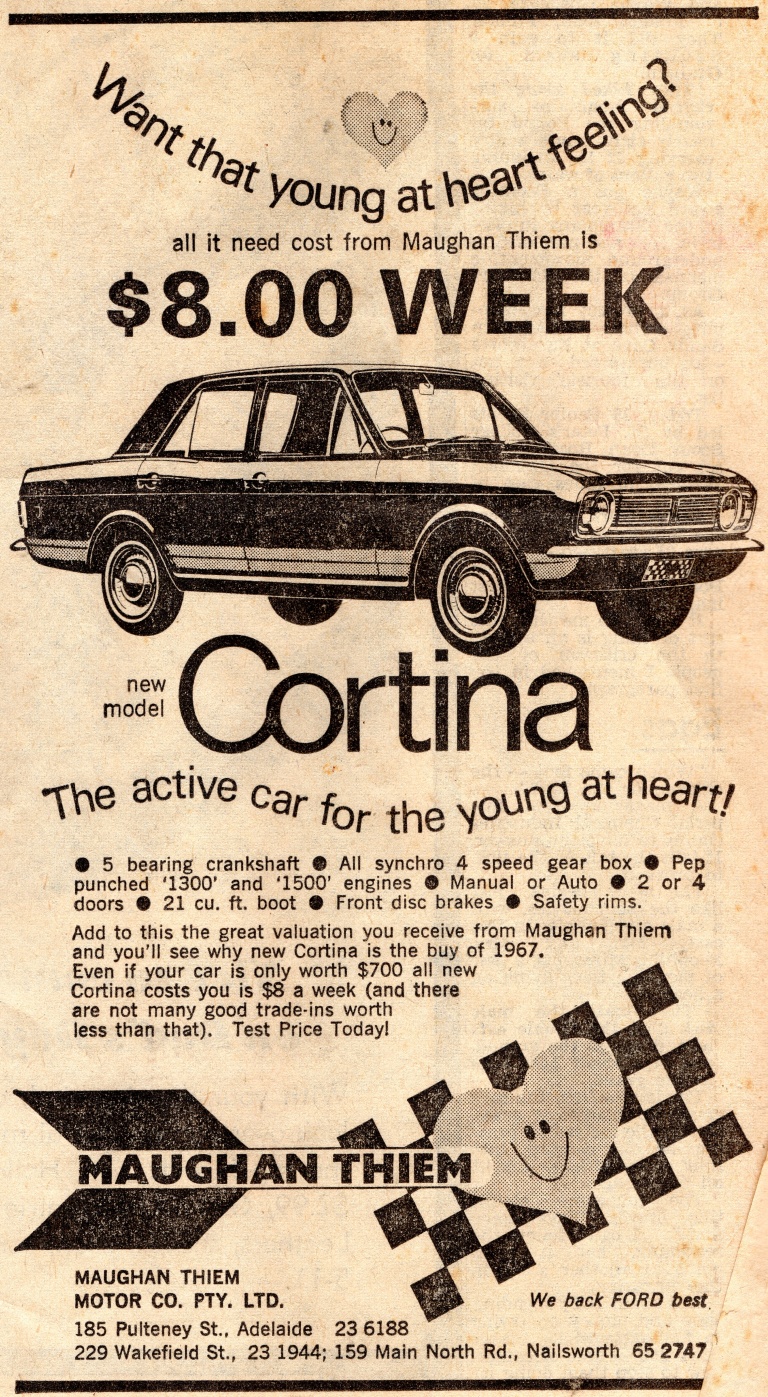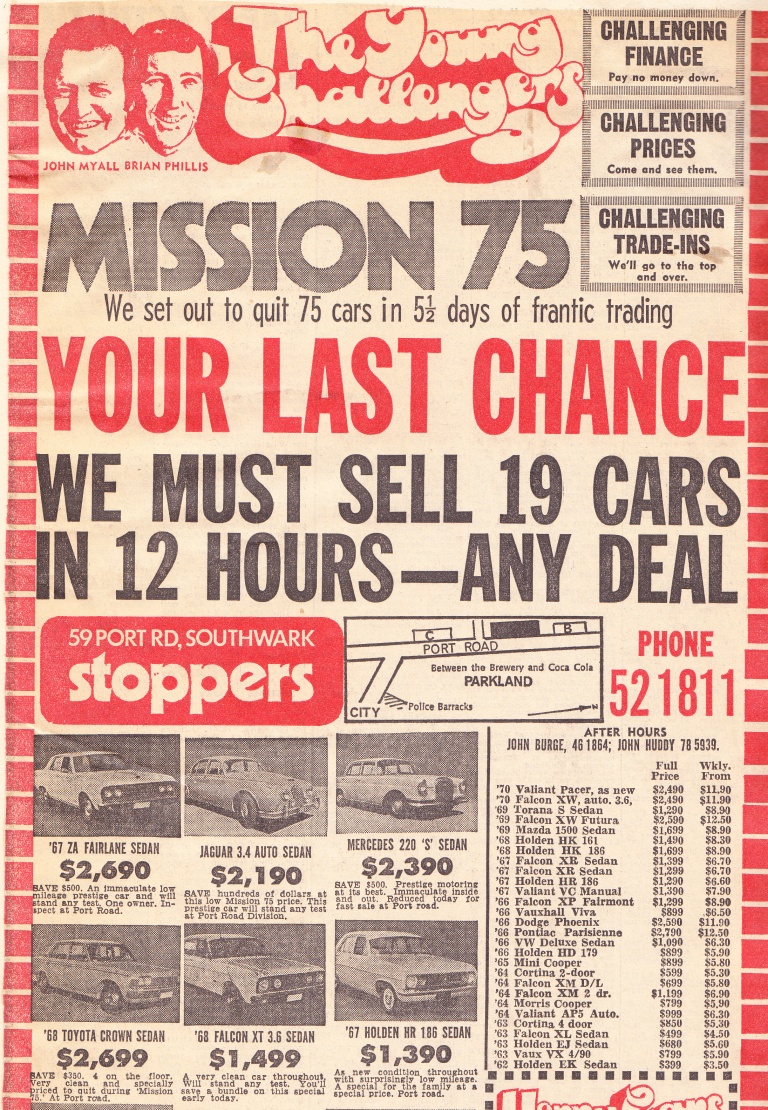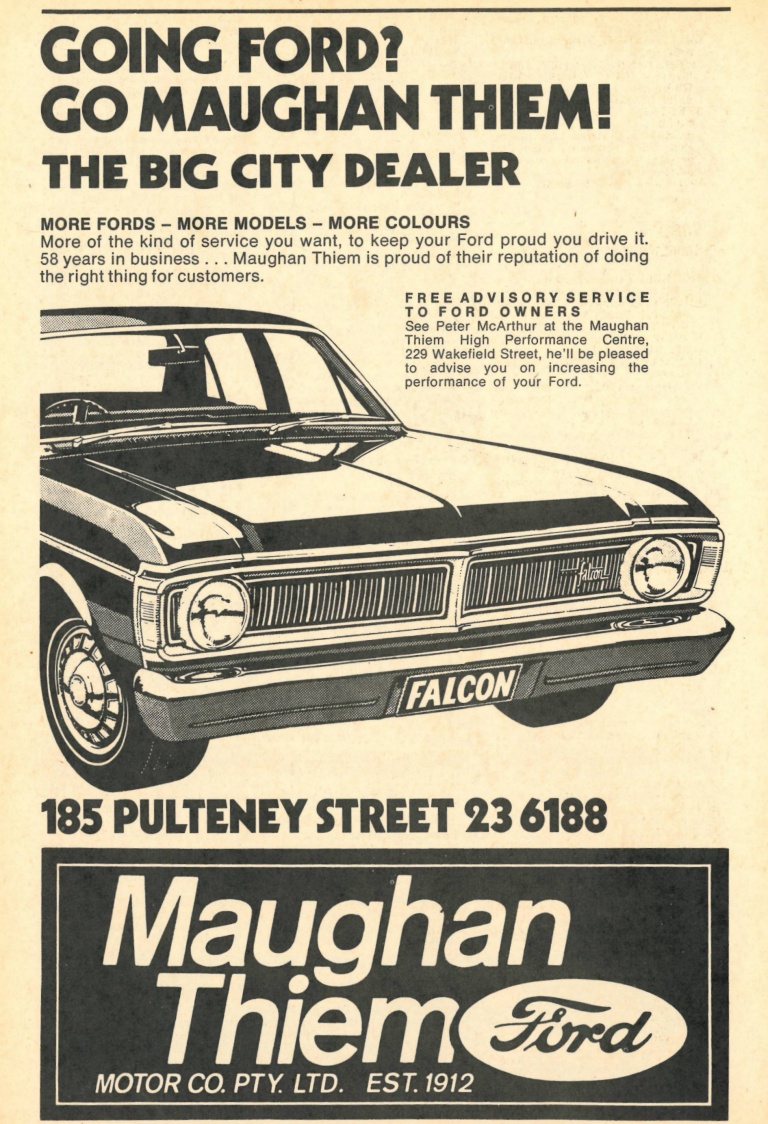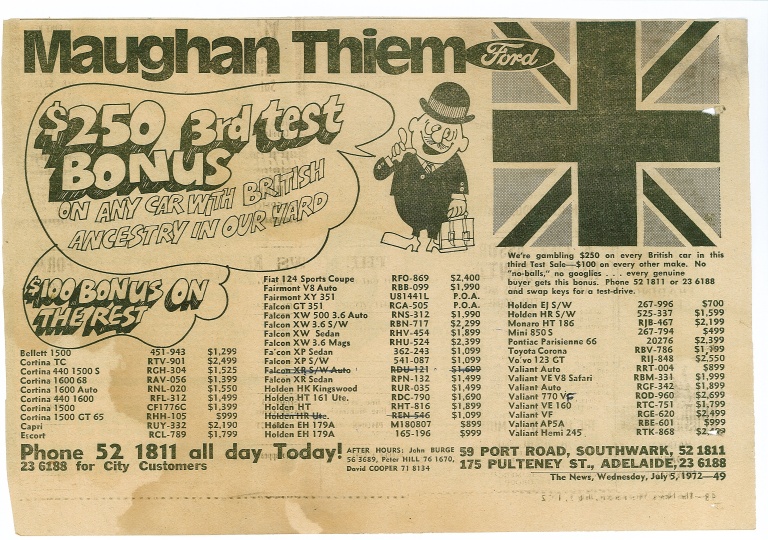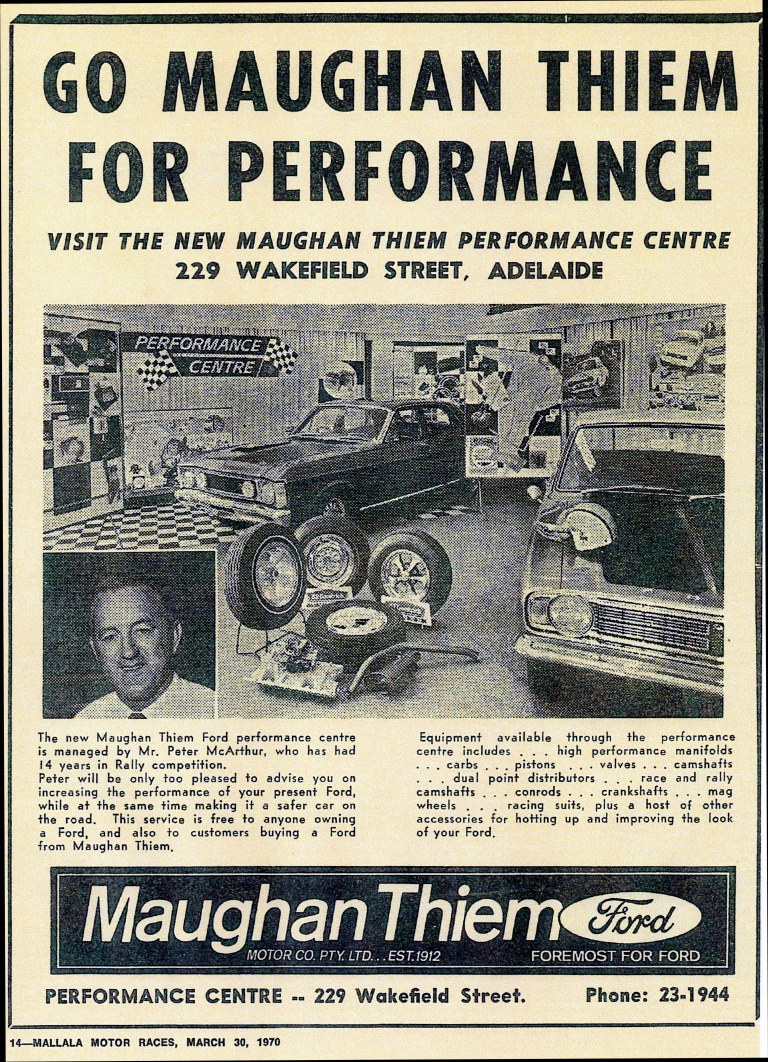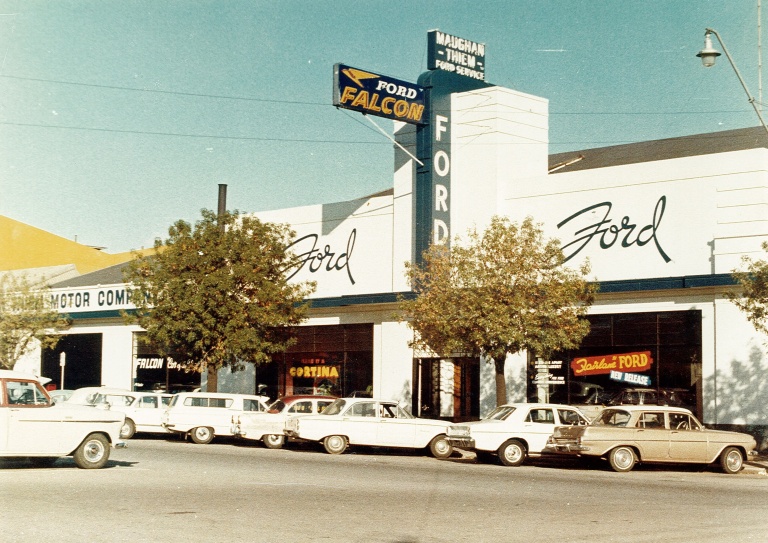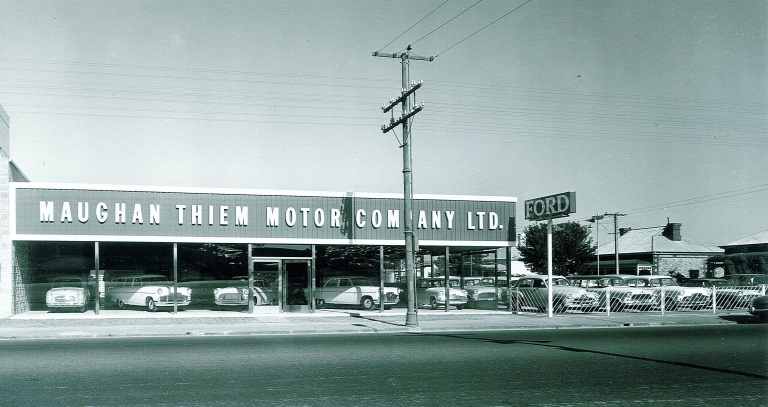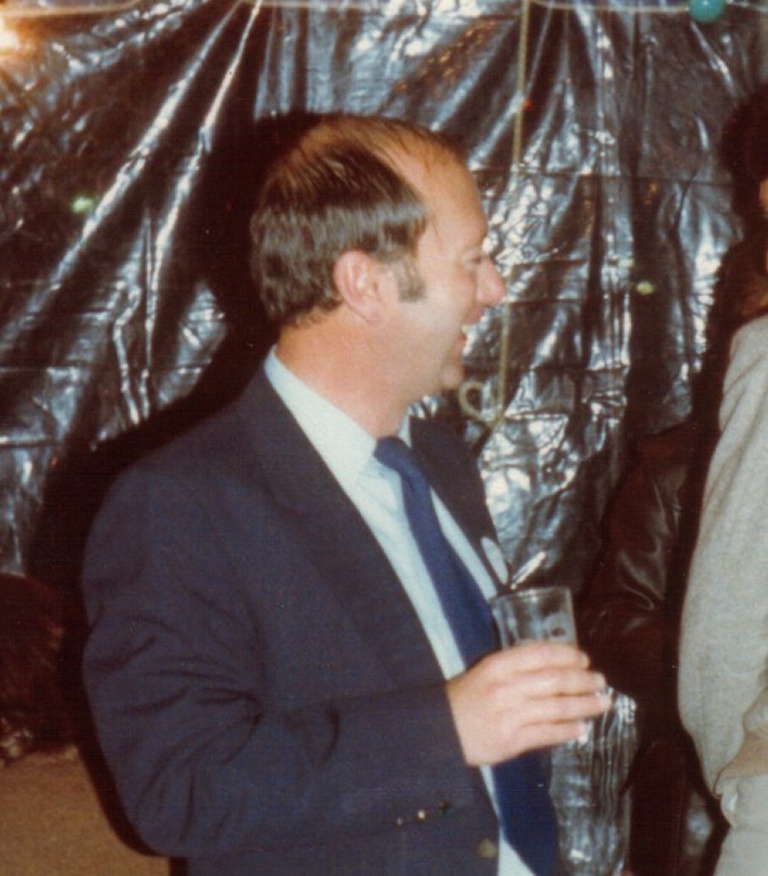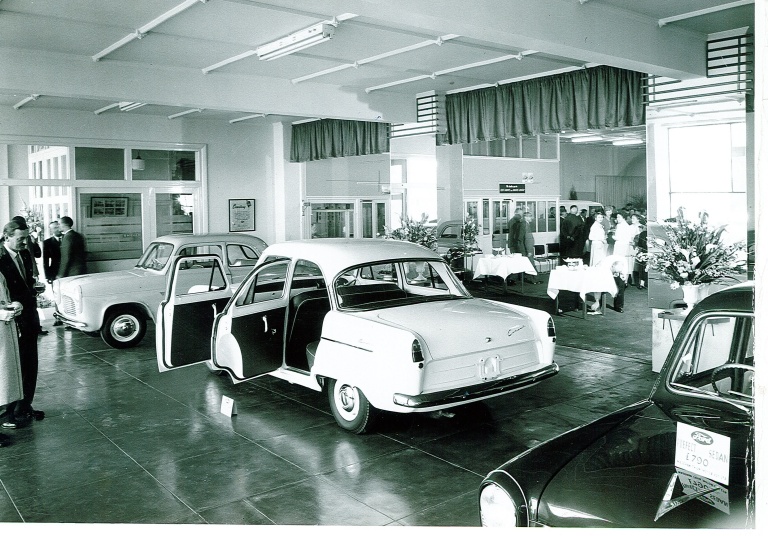1958 - 1972
In June 1958, Maughan Thiem became dealers for Ford's Number 2 Franchise in the metropolitan area. Since it was an exclusive franchise the company relinquished its other lines.
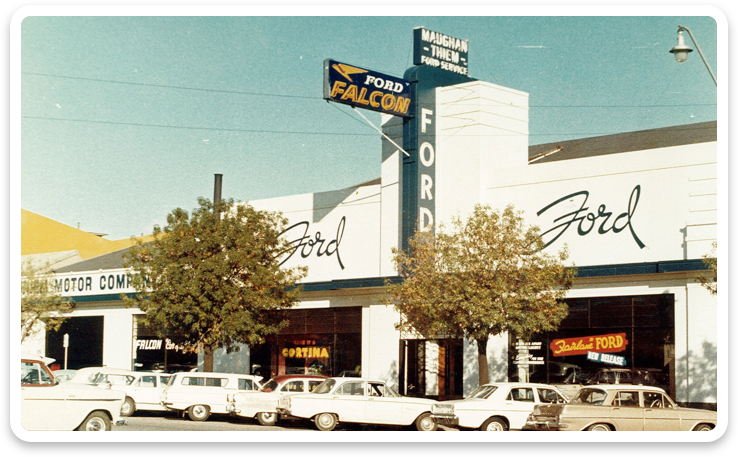
In 1957 the Managing Director, Mr Bruce Thiem, visited England. This visit became an important event for Maughan Thiem, for it resulted in the discussions with the Ford motor company which were to affect Maughan Thiem’s future development.
By 1957 some of the agencies which had done the company good service were beginning to make heavy weather. The Rootes, Nash and Willys lines were losing their appeal to the public, and of the various International products only trucks continued to sell relatively well. The suggestion that the Maughan Thiem company consider applying for the Ford franchise was therefore attractive in a number of ways. Since the 1920s, when the company had eased its way out of its Ford subdealership, the situation had undergone important changes. The Ford car was still one of the best-sellers in Australia, but the ‘Tin Lizzie’ days were over and the Ford no longer attracted the jesting of the Model T days. The Ford was essentially a family car and was not priced beyond the purse of the average middle income family, and it offered a sufficient range of vehicles to interest prospective buyers. Further, the Ford organisation itself seemed a better system within which to operate. In 1924 a delegation from the Ford Motor Company of Canada had visited Australia and concluded that Ford should establish its own subsidiary assembling and body-building factories in Australia. The delegation thought that this would be preferable to the current number of separate agents with small, and sometimes uneconomical, assembly plants. The result was the establishment of the Ford Motor Company of Australia, a direct subsidiary of the Ford Motor Company of Canada, Limited, with an initial capital of five million dollars provided by the parent company. Since those days Ford Australia had grown into a large and complex concern, and the Ford franchise seemed a better package all round. Administratively it seemed simpler to deal in one make of vehicle rather than in several, and Ford was an Australian company with a wide range of products which had an assured market in the State.
Maughan Thiem’s directors certainly took this view, and when Mr Bruce Thiem returned from overseas the company entered into negotiations with Ford and successfully applied for the franchise. And so the wheel turned full circle. In its Behrens & Marshall days the firm had built its reputation and success on its special knowledge of the Ford car; now, in June 1958, Maughan Thiem became dealers for Ford’s Number 2 Franchise in the metropolitan area. Since it was an exclusive franchise the company relinquished its other lines.
The benefits to the company were not immediately apparent. The heavy costs incurred in the changeover had an adverse effect on the first year’s trading, and in fact for that year the consolidated operations of the company and its subsidiaries resulted in a loss. Sales of cars, trucks and used cars noticeably increased, but the transition period produced a steep decline in income from the parts and service divisions. However, during the following year the company reaped its reward. The sale of new and used vehicles exceeded that of the previous year by somewhere in the vicinity of 200 units, and business in parts and services improved. The result was a consolidated profit well in excess of the loss of the previous year.
The optimism of the years following the granting of the Ford franchise was reflected in an expansion of the territory on which the company operated. It has been seen that this had already started before the changeover, but it was intensified when the Ford dealership was taken up.
In June 1958 Maughan Thiem had bought property on 88 Main North Road Prospect. By March 1959 the company concluded that it was not suitable for its purposes and sold it to J.W. Taylor and Sons at a satisfactory price. The company, however, remained interested in expanding operations into the northern area, and in December 1958 it acquired property at 159 Main North Road Nailsworth. This was cleared and tenders were invited for the building of a showroom and used car lot. The contract was given to C.P. Hill & Sons and building commenced by July 1960. By the middle of December the building was completed and operations had commenced; in all, the cost of the land and building totalled about £23,777. This was Maughan Thiem’s first out-of-town showroom. The modern single-storey building had a frontage on Main North Road, and the property was on the corner of California Street, which was a further convenience for prospective buyers seeking parking off the main road. About six new Ford cars were kept on display behind the large plateglass windows of the main showroom, and the used car area held up to fifty vehicles. In addition there were facilities for setting out the full range of Ford products and a workshop capable of maintaining and servicing up to one hundred cars. Maughan Thiem continued to operate on this spacious and attractive property for about ten years.
Continue Reading
At about the same time that building commenced at Nailsworth the company was completing alterations and improvements on its Hindmarsh property. The workshop was updated and a store was built to try to improve sales of spare parts. Amenities such as a new toilet block were added, and the Hindmarsh property was made more serviceable in various other ways. For a time Maughan Thiem believed that it had found the opportunity to extend its property at Hindmarsh and thereby to cater for a growing operation there. In June 1963 the company made an offer for an adjacent property owned by Radio Electrical Wholesalers. In the event the asked price was higher than expected, and in the meantime Maughan-Thiem started to explore a possible expansion into Port Adelaide. Plans for Hindmarsh were therefore temporarily shelved. However, some ten months later projects for developing at Hindmarsh were again revived and the company bought the block opposite its Hindmarsh property on the corner of Orsmond and Adam Streets. The service division was handling an increased volume of business, and the new block seemed ideal as the site for a service centre since it was close to the spare parts store. Once again, however, the development of Hindmarsh had to be abandoned. The architects took longer than anticipated in preparing plans because their offices were damaged. Then when the plans were eventually submitted and costed the directors decided that in view of other proposed extensions elsewhere the original Hindmarsh plans would have to be scaled down for purposes of economy. A more modest set of plans was obtained, and then the final blow fell. When the builders inspected the site they found that most of the block was filled with plaster and rubble and they concluded that heavy building was out of the question. By this time Maughan Thiem was about to move its parts and service operation to Wakefield Street and extensions at Hindmarsh were not as urgent. In all, the new Hindmarsh block turned out to be an unfortunate choice and the directors were relieved to be able to dispose of it even at a loss. The original Hindmarsh premises were retained and used for the storage of new units and for crash repairs.
While the improvements and land transactions were proceeding at Hindmarsh, the company also extended its operations in the truck and used car division. To this end on 1 June 1963 leasehold possession was taken of property at 163 Main North Road Nailsworth, close to the Nailsworth showrooms. For some four years operations were continued on this site, but by October 1967 the used truck yard was moved to a larger block nearby at 179 Main North Road in the hope of boosting the used truck business. Maughan Thiem continued operations there until 1972.
For the company the years 1964 and 1965 were an important period of expansion. As told above, in April 1964 the block at Hindmarsh was purchased to expand the company’s service operations. More importantly, on 18 December 1964 the company celebrated the opening of two showrooms. One of these was the showroom at Pulteney Street, which was re-opened after remodelling and enlargement. It had been increased by 10,000 square feet to a total size of 25,000 square feet and was consequently, according to a press report, South Australia’s largest Ford display area. The other showroom opened on 18 December 1964 was a new venture at Malvern.
On 10 April 1964 the directors confirmed action that had been taken in purchasing a property at 311 Unley Road Malvern, on the corner of Winchester Street, for the price of £7,500. Plans for a modern used car showroom were prepared by Caradoc, Ashton, Fisher, Woodhead and Beaumont Smith, and in August the directors accepted a tender from Hatwell Constructions to carry out the work. The building and its surrounds were tastefully conceived to blend in with Malvern’s garden atmosphere. The showroom building itself was of modern design surrounded by plate glass on three sides, and this was set in a continental arrangement, said to be the first of its kind in South Australia and to be an imitation of the European street cafe. The outdoor stands were of specially designed lawn, rather than of the more conventional asphalt, and on these some twelve used cars were on display each day. Behind the building another thirty used cars were held in readiness, and it was the company’s intention to cater for the tastes of the Malvern populace by selling only good quality late model used cars in this well-designed setting. The Malvern operation was placed under the management of Mr Norman Ahrendt, who until then had been assistant manager of the Pulteney Street used car division.
In addition to these developments, shortly after the new Malvern division was opened Maughan Thiem took up a less fortunate branch dealership at Ashford. This was really in spite of the better judgment of the directors. In February 1965 they were approached by Paramount Motors of 109 Anzac Highway, on the corner of South Road, which found itself in some difficulty and wanted Maughan Thiem to take over the business. At the time Maughan Thiem declined to do so because of the ‘complicated position’ of the Paramount group of companies. There was little financial incentive to do so. However by June 1965 the Ford Motor Company was able to advise Maughan Thiem’s directors that the Ashford premises were available for lease and that the staff there could be taken over with the premises. The directors were still cautious, and it was only after a deal of discussion that they agreed to lease the premises and purchase the stock of spare parts, offer employment to the staff, and operate a branch dealership there. The Ashford premises were consequently leased for twelve months with the right of renewal for a further twelve months, and operations commenced there 2 July 1965. The Annual General Meeting in September 1965 was told that the company hoped to turn it into a profitable addition to the firm’s business, but already by then it was clear that such hopes would be difficult to realise. Sales were not up to expectations, and in fact the company was glad to drop the branch dealership after the first twelve months had expired. A loss of some $20,000 was incurred at Ashford during that year.
Following this period of expansion in 1964 and 1965, during the following year the company began to consolidate its business once again within more restricted boundaries. There were good business reasons for this decision, and it was largely made possible when Dalgety & New Zealand Loan Limited, the oldest surviving Ford dealer, decided to withdraw from the Ford franchise. The premises occupied by Dalgety at 229 Wakefield Street consequently became available for purchase or lease from the Ford company, which approached Maughan Thiem with the suggestion that the company consider taking over the site. On 3 May 1966 the directors decided to lease the premises for ten years with the right of renewal. The lease commenced on 6 June 1966, and on that day the parts and service divisions of the company started operations at the new Wakefield Street location. The decision to operate from Wakefield Street made it easier in turn to relinquish some other projects and scattered operations. In June 1966 the branch dealership at Ashford was abandoned, and at about the same time the block of land at Hindmarsh was sold. Further, by July 1966 the Ford company had agreed to make an offer for the property at Unley Road Malvern. The Malvern operation, too, was proving to be a burden to the company. Sales were reasonably satisfactory, but the overhead involved in running the division as a separate establishment proved to be excessive. Ford made final settlement on this property on 11 November 1966 and Maughan Thiem withdrew from Malvern. For the moment the company found it more economical to work from its new Wakefield Street headquarters and fewer outlying sites, and it saw no reason at that time to retract its boundaries any further. The company still kept its new and used car showroom at 159 Main North Road Nailsworth and the truck yard at 163 Main North Road. It retained Hindmarsh for predelivery, storage of new vehicles, and panel repairs, and it also kept the re-modelled showroom at 185-9 Pulteney Street and the used car showroom at 175 Pulteney Street and the truck showroom at Flinders Street.
By this time the Maughan Thiem Motor Company, which together with its three wholly-owned subsidiaries had converted to a proprietary company on 18 October 1963, was well established in the Ford business. In June 1961 it was given the full Ford franchise to handle all Ford lines. This meant that it could distribute the Falcon and Fairlane as well as the English range of vehicles, and the annual report for 1962 observed that the new model Falcon had greatly improved trading during the previous year. Indeed, the twelve months to 30 September 1963 set new records for the company. Maughan Thiem won every dealer competition run by the Ford Motor Company, and for ten of the twelve months topped the Ford sales figures for the metropolitan area. It was not only the new and used vehicle business that prospered. In 1961 and the later 1960s the company did well in the parts and service divisions, and 1970 was a record year. In June 1968 it was the opinion of the company’s auditors that Maughan Thiem was firmly entrenched as the largest Ford dealer in the State.
From 1 April 1969 Maughan Thiem extended its Ford dealership even further when the company was appointed as one of the two heavy truck specialists for the Adelaide metropolitan area. Nevertheless the truck business was not one of the company’s success stories in this period. In 1967 the used truck yard had been moved from 163 to the larger 179 Main North Road Nailsworth in an attempt to improve the trade, but this hope was not fully realised. Moreover the Ford range of commercial vehicles and trucks found a disappointingly meagre market and Maughan-Thiem found it very difficult to promote it. In May 1971 the company’s directors considered a request from the Ford company to become the South Australian truck distributors, but by then it was already evident that the company might not continue much longer in truck sales and the request was declined. The necessary financial outlay would not have been warranted, it was decided. The following year the lease on the Nailsworth truck yard was in fact allowed to expire.
It was not only in the truck and commercial vehicle business that the motor trade was becoming increasingly competitive. Japanese vehicles penetrated the market to a greater extent, and Ford also faced determined rivalry from the other popular locally-produced cars. The millionth Holden car, for example, was produced 25 October 1962, and for many years the Chrysler Valiant was a firm competitor. To be sure, the appearance of a new model from time to time helped Ford dealers to take from their rivals a larger slice of the market. The XR Falcon in 1966, a new Cortina in August 1967 and the XT Falcon in 1968 boosted Maughan Thiem’s sales, and the year ended 30th June 1970 saw a record of 2,926 vehicle sales by the company. In other years, however, the competition was harder to meet and, further, the increasing cost of selling and of administration offset the profits arising from any increase in vehicle turnover. In this respect 1971 to 1973 were hard years. In one year gross profit rose by 9.4 per cent but expenses, mainly salaries and wages, rose by 13.5 per cent.
Directors’ reports drew attention to the drain on the company’s profitability caused by the increased costs of advertising, salaries, and maintenance and guarantee of used cars. In 1972 the country’s economy worsened and the sale of vehicles actually dropped.
For a while the company sought to attract more business by changing the location of some of the sites on which it operated. In 1969 a property was purchased at 256-258 Wakefield Street to provide parking near the service division at 229 Wakefield Street and as a possible site for later expansion. In the same year the purchase of a further used car outlet was decided. This was at 59-67 Port Road Southwark, a large property with a frontage of 300 feet on Port Road. Operations commenced in May 1970, although the office building was not completed until October of that year. At about the same time the company decided to withdraw from its Nailsworth site. In April 1970, after discussing the profitability and prospects of the branch at 159 Main North Road Nailsworth, the directors decided to sell it if a satisfactory price could be obtained, and during the following year the premises were sold at an acceptable capital gain. The leased premises at 179 Main North Road were vacated in May 1972. Maughan Thiem had terminated its agreement with Ford for the distribution of heavy trucks in July 1971, and the Nailsworth truck yard was no longer required. The remaining stock of used trucks was moved to Port Road Southwark.
While this partial relocation was taking place the directors recognised that, in the prevailing economic climate, a bolder and more direct reorganisation at the centre of their business might be desirable. Despite the slight consolidation in 1966 the company was still dissipating its resources over too wide an area and entailing increased overhead and other expenses to do so. Further, if the company were to be consolidated under one roof then a suburban site rather than one in the city had obvious economic attractions. Such thoughts might have remained matters for occasional discussion at directors’ meetings, however, had the chance not come in 1972 to put them into practice.
This came about when Bowden Ford changed its premises. That company sought permission from Ford to transfer its dealership to the Paramotors site at West Terrace, and at the same time it wanted a city location to complement its proposed relocation to West Terrace. Ford had been made aware of Maughan Thiem’s thinking about a suburban consolidation and consequently approached the company about relinquishing its Wakefield Street tenancy to accommodate Bowden Ford. A special meeting of Maughan Thiem’s directors on 28 August 1972 considered the details of a proposition put up by Ford. This was that Maughan Thiem vacate Wakefield Street and relocate its entire operation at 1013 Port Road Cheltenham. The directors saw this as the opportunity they had been looking for. They could see the possibility that business could be lost during the move and re-establishment on the new site, but they believed nevertheless that such a move would be more economical in the long run and that any lost ground would be recovered. They therefore accepted Ford’s proposal, and in September 1972 the company moved to its present premises at 1013 Port Road Cheltenham.
With the business consolidated on Port Road the company was able to dispose of its other properties. The leased premises in Flinders Street and Pulteney Street were vacated. By November 1972 the parking lot at 256-8 Wakefield Street had been sold, and on 15 December 1972 the sale of the Southwark used car lot was completed. The premises at Hindmarsh, which had served the company since 1937, were also sold. The company had in fact considered getting rid of this earlier when the proposed Metropolitan Adelaide Transportation Study (M.A.T.S.) plan was under discussion and it had seemed likely that the Highways Department would require it for an interchange at Hindmarsh. At the time the company had eventually seen advantages in retaining the property until it was compulsorily acquired; but now the time to dispose of it was seen to have come, and by August 1974 sale of this property to the Highways Department was finalised. Accommodation was now required for the company’s crash repair, predelivery and used car operations, as well as for the storage of new cars, and the new site on Port Road was consequently extended by the purchase of four blocks at the rear of the premises in Fourth Avenue Cheltenham.
As was foreseen, the move to Cheltenham had an adverse effect on all departments of the company’s business during the first year on the new site, but the following year’s trading returned an all-time record net profit. Since then the company has shared the general Australian experience of inflation and a stringent economy. In 1980 the total new car market in South Australia dropped by 10.1 per cent, and Maughan Thiem had its fifth successive year of declining new vehicle sales. However, the company has always known that there is more to the motor trade than the sale of new vehicles, and as this aspect of the business has temporarily declined the parts, service and used car divisions have restored buoyancy to the company’s trading.
Maughan Thiem has still occasionally found it desirable to lease additional sites for the display and sale of used vehicles. A small used car lot was taken for a while from 18 February 1974 at 590 Port Road Allenby Gardens, and from March 1976 to March 1979 property was taken in Regency Road Kilkenny for the sale of used cars and caravans. Apart from such minor excursions, however, the entire business has remained on the one site, and it has continued to prosper there as it has done over the seventy years of its history.
